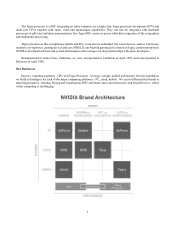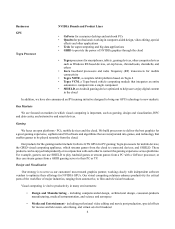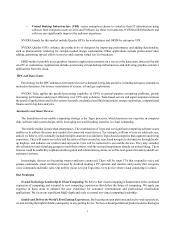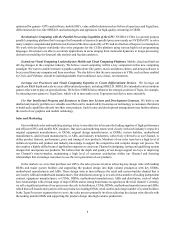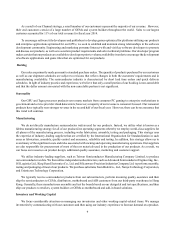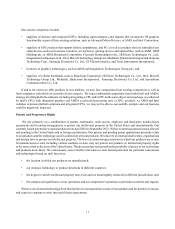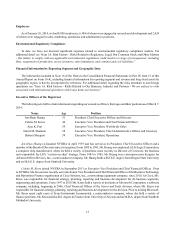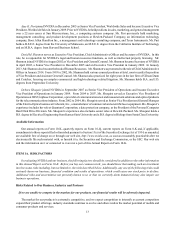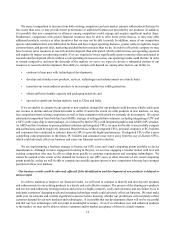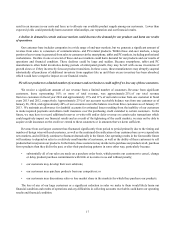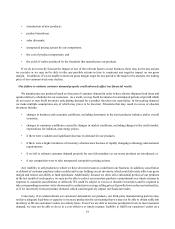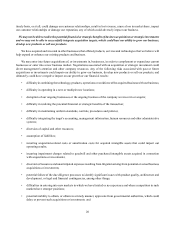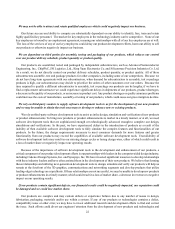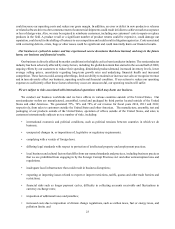NVIDIA 2013 Annual Report Download - page 159
Download and view the complete annual report
Please find page 159 of the 2013 NVIDIA annual report below. You can navigate through the pages in the report by either clicking on the pages listed below, or by using the keyword search tool below to find specific information within the annual report.15
Our ability to successfully develop and deliver new products will depend on various factors, including our ability to:
• effectively identify and capitalize upon opportunities in new markets;
• timely complete and introduce new products and technologies;
• transition our semiconductor products to increasingly smaller line width geometries; and
• obtain sufficient foundry capacity and packaging materials.
We occasionally have experienced delays in completing the development and introduction of new products and product
enhancements, and we could experience delays in the future. In addition, in the past, we have faced challenges in managing
product transitions from older to newer products resulting in obsolete inventory. Our failure to successfully develop and
introduce new products and technologies or identify new uses for existing or future products could result in rapidly declining
average selling prices, reduced demand for our products or loss of market share, any of which could harm our competitive
position and cause our revenue, gross margin and overall financial results to suffer.
If we are unable to achieve consumer and market acceptance and design wins for our products and technologies, our
results of operations and competitive position will be harmed.
The success of our business depends to a significant extent on our ability to achieve consumer and market acceptance
of our new products and enhancements to our existing products and identify and enter new markets, such as cloud-based
computing appliances, servers, automotive technology, smartphones, tablets, video game consoles, and other similar
consumer electronic devices. The markets for our products and technologies are characterized by unpredictable and
sometimes rapid shifts in the popularity of products, often caused by the publication of competitive industry benchmark
results, changes in pricing of dynamic random-access memory devices and other changes in the total system cost of add-
in boards, or AIBs, as well as by severe price competition and by frequent new technology and product introductions. Broad
consumer and market acceptance is difficult to achieve and such consumer and market acceptance, if achieved, is difficult
to sustain due to intense competition and frequent new technology and product introductions. Our success in achieving
consumer and market acceptance will depend in part on our ability to cultivate new industry relationships and improve the
functionality of our products as the number of internet-connected devices increases. If we do not successfully achieve or
maintain consumer and market acceptance for our products and enhancements or identify and enter new markets, our ability
to compete and maintain or increase revenues will suffer.
We believe achieving design wins, which entails having our existing and future products chosen for hardware
components or subassemblies designed by original equipment manufacturers, or OEMs, original design manufacturers, or
ODMs, and AIB and motherboard manufacturers, is an integral part of our future success. Our OEM, ODM, and AIB and
motherboard manufacturers' customers typically introduce new system configurations as often as twice per year, typically
based on spring and fall design cycles or in connection with trade shows. Accordingly, when our customers are making
their design decisions, our existing products must have competitive performance levels or we must timely introduce new
products in order to be included in our customers' new system configurations. This requires that we:
• anticipate the features and functionality that customers and consumers will demand;
• incorporate those features and functionalities into products that meet the exacting design requirements
of our customers;
• price our products competitively; and
• introduce products to the market within our customers' limited design cycles.


